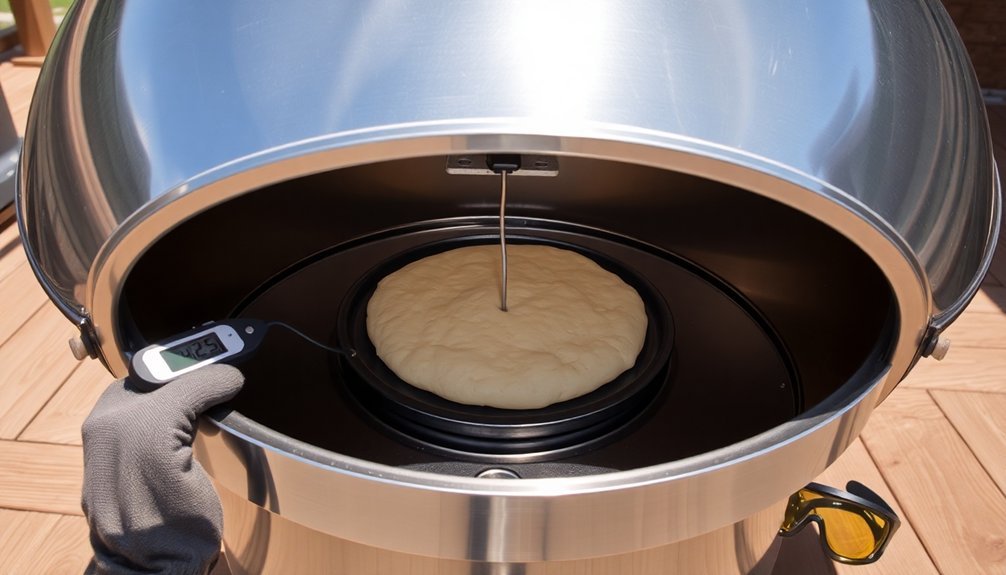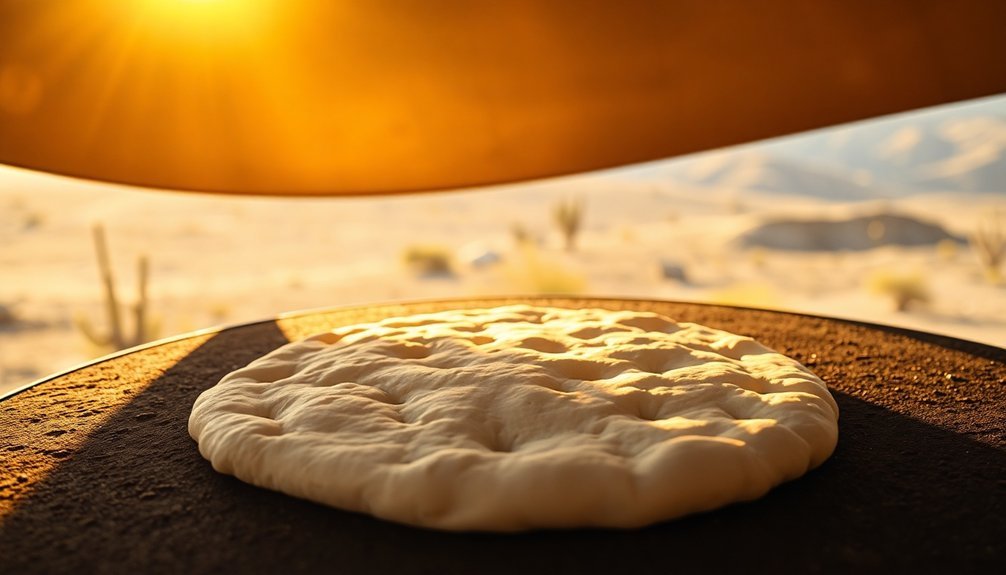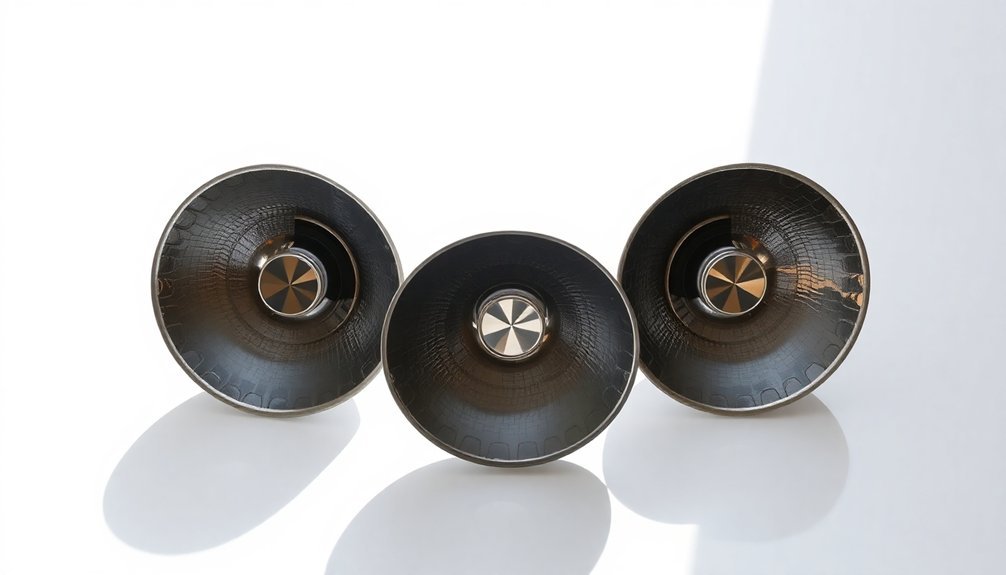You can bake pizza using solar power by creating a simple DIY solar oven from a cardboard pizza box. Line the box's lid with aluminum foil, add a reflective flap, and create a transparent window using plastic wrap to trap heat. Place black construction paper inside as a heat absorber, and position your oven in direct sunlight. After preheating for 30-50 minutes, place your prepared pizza dough inside and monitor the temperature – you'll want it around 300°F for proper baking. The process typically takes 20-40 minutes, depending on weather conditions. Master a few key techniques, and you'll transform sunlight into perfectly baked pizza.
Understanding Solar Oven Mechanics

Through the innovative use of vacuum tube technology and specialized materials, solar ovens harness the sun's energy to create an efficient cooking environment. The cooking chamber employs borosilicate glass with a vacuum layer between two walls, providing superior insulation that prevents heat from escaping.
Inside the tube, specialized metal coatings of aluminum nitride, stainless steel, and copper work together to absorb and reflect heat effectively. This advanced design allows temperatures to reach up to 550°F while staying cool to touch.
You'll notice that compound parabolic reflectors play an essential role in concentrating sunlight from various angles onto your cooking tube. These reflectors eliminate the need for constant adjustments as the sun moves across the sky.
The heat bank technology, featuring a conductive aluminum chassis, stores thermal energy to maintain steady cooking temperatures even when sunlight becomes inconsistent.
The oven's efficiency relies on multiple heat-trapping mechanisms. Black surfaces convert sunlight into heat, while clear materials like plastic wrap or glass create a greenhouse effect.
You'll achieve ideal results between 11am and 3pm when the sun's intensity is highest, reaching temperatures between 160-200°F.
Even in challenging weather conditions, advanced solar ovens can maintain their cooking performance.
Essential Tools and Materials
Building on your understanding of solar oven mechanics, let's gather the materials needed for your solar-powered pizza adventure.
You'll need a cardboard pizza box or two nesting boxes as your oven's foundation, along with aluminum foil to reflect sunlight and clear plastic wrap to create a window. Black construction paper will serve as your heat absorber, while newspapers, packing peanuts, or Styrofoam will provide essential insulation. Line the interior walls carefully to maximize heat retention.
For your pizza dough, gather all-purpose or bread flour, water, olive oil, and salt. You can choose between two routes: a quick no-yeast dough using baking powder, or a traditional yeast-based dough that requires additional sugar and garlic powder for flavor.
Don't forget cooking aids like an oven thermometer to monitor temperature, tape for assembly, and a wooden skewer to prop the lid.
You'll also need tools for construction and cooking: a box knife or scissors, ruler, and a pizza tray or aluminum pie pan coated with olive oil.
Once your oven's ready, have your pizza sauce and toppings prepared. For initial oven testing, keep graham crackers, marshmallows, and chocolate handy to guarantee proper heating.
Assembling Your Solar Pizza Oven

A well-assembled solar pizza oven starts with precise cuts and careful measurements. Using your ruler and marker, draw lines on three sides of the pizza box lid, leaving a 1-inch border. Make your cuts along these lines, keeping one side uncut to create a flap that'll form your oven's reflective surface.
Line the flap with aluminum foil, ensuring it's smooth and wrinkle-free for maximum light reflection. Next, cover the bottom of your box with aluminum foil and layer black construction paper on top, securing both materials with glue or tape. This combination creates an effective heat-absorbing surface. Your solar oven can reach temperatures up to 500 degrees Fahrenheit when properly constructed.
Create a transparent window by stretching plastic wrap across the opening. Secure it tightly on both the top and bottom of the box, eliminating any wrinkles that could reduce sunlight penetration. You'll need this seal to trap heat inside your oven.
Finally, construct an adjustable stand using straws or a wooden dowel to prop up your reflective flap. Tape the straws together for stability, and seal the box's edges with clear tape. You can adjust the flap's angle throughout the day to capture maximum sunlight and maintain ideal cooking temperatures.
Preparing The Pizza Dough
Making pizza dough for your solar oven requires three essential steps: activating the yeast, mixing the ingredients, and allowing proper proofing time.
You'll start by combining warm water with yeast and sugar, letting the mixture sit until it becomes frothy and active.
In a large bowl, sift 800-900g of flour and mix in the garlic powder and salt. Add four tablespoons of olive oil to your dry ingredients, then incorporate the activated yeast mixture.
Knead the dough for at least five minutes, keeping some extra flour nearby to adjust the consistency if needed.
Once you've achieved a smooth, elastic dough, it's time for proofing. Let it rise in a warm place for 1-2 hours, or overnight in the refrigerator if you're planning ahead.
When you're ready to shape the pizza, divide the dough into portions and flatten each piece using your fingers and knuckles. Keep the edges thicker for a puffy crust, and guarantee the center is thin but without holes.
Remember not to overwork the dough, as this can make it tough. Before adding toppings, transfer your shaped dough to an oiled pan.
Setting Up Optimal Cooking Conditions

Position your solar oven in a spot that receives direct sunlight throughout the cooking process, ideally when outdoor temperatures are above 75°F.
You'll need to adjust the reflector flap to a 90-degree angle and rotate the oven periodically to track the sun's movement across the sky.
To achieve the best baking temperature for your pizza dough, make sure the black paper heat sink is firmly attached to the bottom and the plastic wrap seal is completely intact to maintain temperatures between 160-200°F.
#
Positioning Your Solar Oven
Success with solar pizza baking depends heavily on proper oven placement and timing. You'll want to position your solar oven in a south-facing direction, particularly during winter months when sunlight is less abundant. The ideal cooking window falls between 10 a.m. and 2 p.m., when the sun's UV rays are most direct and intense.
Set up your oven by adjusting the foil-covered reflective flap to direct maximum sunlight through the plastic-covered window. You'll need to guarantee the aluminum foil is smooth and secured firmly to create a mirror-like surface that efficiently reflects sunlight into the cooking chamber.
Position a ruler or similar object to maintain the perfect angle of reflection, and make certain your transparent lid or plastic wrap creates an airtight seal to trap heat inside.
As the sun moves across the sky, you'll need to reposition your oven every 30-45 minutes to maintain direct sunlight exposure. In summer, you'll have more flexibility with cooking times, but winter requires stricter adherence to peak hours.
Remember that cloudy conditions will notably impact your pizza's cooking time, so choose a clear, sunny day for best results.
Maximizing Temperature Control
Temperature control stands at the heart of successful solar pizza baking. You'll need to maintain temperatures between 150-225°F for proper dough cooking, which requires careful monitoring and adjustment throughout the baking process. Use a reliable thermometer to track your oven's internal temperature and make necessary modifications as the sun moves.
To maximize heat retention, line your pizza box with black construction paper and seal it tightly with clear plastic wrap or heavy-duty plastic. Install multiple reflective surfaces using aluminum foil, keeping them smooth and properly angled to direct sunlight onto your cooking surface.
| Temperature Phase | Required Action | Expected Result |
|---|---|---|
| Preheating | Position oven 30 min before cooking | Reaches baseline temp |
| Heat Building | Adjust reflective panels | Achieves cooking temp |
| Maintaining | Monitor thermometer readings | Steady cooking temp |
| Adjusting | Reposition oven as sun moves | Consistent heat |
Use dark-colored, lidded cookware to enhance heat absorption, and surround your cooking cavity with insulating materials like crumpled newspaper. Pre-heat both the oven and cookware before adding your pizza dough to guarantee consistent temperatures throughout the baking process.
## Positioning Your Solar Oven
Position your solar oven in a spot that receives direct, unobstructed sunlight for at least 30-45 minutes each hour to guarantee consistent cooking temperatures.
You'll want to adjust the aluminum foil reflector flap to approximately 60 degrees for ideal sunlight capture, using a ruler to prop it at the right angle.
As the sun moves across the sky, you'll need to reposition both the oven and reflector flap regularly to maintain maximum heat and cooking efficiency.
Finding Direct Sunlight
When baking pizza dough with solar power, finding the perfect location for your solar oven is essential for success.
You'll need to scout a spot that receives uninterrupted sunlight with minimal to no shadows throughout your cooking time. Position the oven so it faces directly into the sun, and make sure there aren't any trees, buildings, or other obstacles that could cast shadows as the sun moves.
Choose a clear, sunny day for your pizza-making venture, though a few scattered clouds won't ruin your baking plans as long as you're getting 30-45 minutes of good sunlight each hour.
While ambient temperature isn't critical, cooking above 75°F will give you better results. You'll need to adjust your oven's position regularly to maintain direct sun exposure as the sun moves across the sky.
Don't forget to take into account wind protection when selecting your spot. Strong gusts can disturb your cooking process or even flip the oven over.
Look for a naturally sheltered location, or create a windbreak to protect your setup. If needed, anchor your oven to prevent any wind-related mishaps during the baking process.
Angles for Maximum Heat
Setting up your solar oven at the ideal angle stands out as one of the most essential steps for achieving pizza-baking temperatures. You'll need to position your reflector flap at an angle that maximizes sunlight concentration into the cooking area, using a ruler or similar object to prop it open.
To find the best angle, you'll want to take into account the sun's altitude, which varies throughout the day and seasons. Use an online calculator to determine the sun's position for your specific location and time. During summer, you'll typically get the highest sun altitude around noon on June 21, while spring and fall seasons require different adjustments.
Line your reflector flap with smooth aluminum foil to create an efficient reflective surface. You'll need to reposition your oven frequently as the sun moves across the sky – this helps maintain consistent heat for your pizza dough.
Make sure you've sealed the box with clear plastic wrap and lined the bottom with black construction paper to trap heat effectively. Keep a thermometer handy to monitor temperature changes, and adjust your angles accordingly for maximum heat concentration.
Temperature Control Basics

Understanding temperature control is vital for successful solar pizza baking, since your oven's heat determines how well the dough will rise and cook.
You'll need to get your solar oven to at least 300°F for proper pizza baking, which takes about 20 minutes of preheating in strong sunlight. For ideal results, position your oven directly facing the sun and adjust it every 30-45 minutes to maintain consistent heat.
Your solar oven's design plays a key role in reaching and maintaining the right temperature. Use aluminum foil-lined reflectors to direct sunlight into the oven, and make sure you've got proper insulation with materials like crumpled newspaper or spun fiberglass. A glass or heavy-duty plastic cover will trap heat through the greenhouse effect.
For the best pizza baking results:
- Choose a warm day (75°F or above) during peak sun hours (10 AM – 4 PM)
- Set up in a wind-protected area to prevent heat loss
- Monitor the internal temperature with a thermometer, aiming for 150-225°F for consistent cooking
Remember that cloudy conditions will greatly reduce your oven's efficiency, so plan your solar pizza baking for clear, sunny days.
Monitoring The Baking Process
Proper monitoring of your pizza's baking progress will make the difference between a perfectly cooked solar-powered pie and an undercooked disappointment. You'll need to keep a close eye on your pizza without opening the oven, as this will release the trapped heat and extend your cooking time.
Install a thermometer inside your solar oven to track the internal temperature. You can observe your pizza's progress through the plastic window you've created, watching for the cheese to melt completely and ensuring the toppings are heated through. The typical baking time ranges from 20 to 40 minutes, depending on your oven's temperature and sunlight conditions.
Don't leave your pizza in the solar oven for more than an hour, as this can lead to bacterial growth. You'll know your pizza is ready when the cheese has melted fully and the toppings are steaming hot.
Once it's done, remove it carefully using oven mitts or tongs, as the contents will be hot. It's important to serve and eat your solar-baked pizza immediately after cooking to maintain food safety standards and enjoy the best results.
Testing Pizza Dough Readiness

Before baking your pizza in a solar oven, you'll need to verify your dough has reached the ideal proofing stage. The most reliable method is to monitor the dough's volume – it should double in size during proofing. You'll want to compare its current size to when you first started proofing to guarantee proper development.
The poke test offers another foolproof way to check readiness. Press your finger gently into the dough and observe its response. If it springs back halfway and slowly, you're ready to proceed. However, if it bounces back quickly or doesn't spring back at all, your dough needs more time or is over-proofed, respectively.
When preparing to shape your dough, look for these key indicators:
- The dough should feel soft and relaxed, not tight or resistant.
- When pressed, it should stretch easily from the center outward.
- The surface should appear smooth with no tears or resistance.
If you notice any resistance while shaping, let the dough rest for 10-15 minutes under cover.
Remember to bring refrigerated dough to room temperature and lightly coat your hands with olive oil before handling.
Common Solar Baking Challenges
When baking pizza with solar power, you'll encounter several unique challenges that require careful attention and adjustment. The most notable hurdle is maintaining a consistent temperature, as your solar oven will only reach about 200°F, which is lower than conventional ovens. You'll need to monitor the internal temperature with a thermometer and adjust the reflector flap periodically to compensate for temperature fluctuations.
Weather conditions will greatly impact your baking success. Cloud cover can reduce heating capability, so you'll need to choose sunny days for ideal results. As the sun moves, you'll have to reposition your oven every 10-15 minutes to maintain direct sunlight exposure. Using insulation materials like newspapers can help retain heat during these adjustments.
The extended cooking time poses another challenge. Your pizza crust will take over an hour to achieve a crispy texture, much longer than in a conventional oven.
To guarantee even cooking, you'll need to rotate the pizza regularly and adjust the foil-covered flap to maximize sunlight reflection. Using a clear glass or aluminum plate can help distribute heat more evenly across your pizza dough.
Solar Baking Safety Measures

When you're baking pizza in a solar oven, you'll need to check your food thermometer frequently to confirm the dough reaches at least 165°F for safe consumption.
You must use heat-resistant gloves and proper cookware designed for solar ovens to prevent burns and guarantee even cooking.
Keep an eye on weather conditions and position your solar oven away from flammable materials, adjusting its angle every 1-2 hours to maintain ideal sunlight exposure between 11 AM and 3 PM.
Monitor Temperature Regularly
Keeping tabs on your solar oven's temperature is vital for safe and effective pizza baking. You'll need to pre-heat your solar oven for 30-50 minutes in direct sunlight, monitoring the temperature rise from around 80°F until it reaches the ideal pizza-baking range of 200-300°F. Use a reliable thermometer to track these changes, as temperatures can climb rapidly, sometimes jumping to 126°F in just a minute.
For successful pizza baking, follow these significant temperature monitoring steps:
- Check the oven temperature every 10-15 minutes, adjusting the oven's position to maintain consistent heat.
- Guarantee the internal temperature stays above 125°F to prevent bacterial growth, particularly important for pizza toppings.
- Reposition your solar oven every 1-2 hours to follow the sun's movement, maintaining peak cooking temperatures.
Keep in mind that peak solar cooking hours are between 11 AM and 3 PM. Use dark-colored, tight-fitting lids on your pizza pan to retain heat, and always consider weather conditions that might affect cooking temperatures.
If clouds appear, you may need to extend cooking time or adjust the reflectors to maintain safe baking temperatures.
Equipment Safety Guidelines
Setting up your solar baking equipment calls for careful attention to safety measures, both in preparation and during use.
You'll need to start with properly calibrated tools, especially your digital probe thermometer, which must provide accurate temperature readings for safe pizza baking. Keep your thermometer and other equipment protected from extreme conditions that could affect their performance.
When handling your solar cooker, always use protective gear as the surfaces can become extremely hot, particularly with parabolic designs.
You'll want to maintain strict hygiene by cleaning and sanitizing all utensils, dishes, and cooking surfaces before and after use. If you're using utility knives during setup, make sure there's adult supervision to prevent injuries.
Choose dark metal cookware for ideal heat absorption and retention.
Create an effective heat sink using black paper, and seal openings with plastic wrap to maximize the greenhouse effect.
You'll need to position your reflective materials, like aluminum foil, carefully to direct sunlight efficiently into the cooker.
Keep your ingredients in sealed, insulated containers until you're ready to use them, and always handle raw and cooked items separately to prevent cross-contamination.
Weather-Related Precautions
Successful solar baking requires careful attention to weather conditions and environmental safety. When baking pizza dough using solar power, you'll need clear skies and direct sunlight to achieve proper cooking temperatures. Monitor local weather forecasts and avoid solar baking during cloudy periods or when strong winds might destabilize your equipment.
For peak safety and cooking results, follow these essential weather-related precautions:
- Set up your solar oven on a stable, fire-resistant surface like concrete, away from flammable materials such as dry grass, brush, or pine straw – especially during drought conditions.
- Position your oven to maximize sun exposure, adjusting its angle throughout the cooking process to maintain consistent temperatures above the danger zone (125°F).
- Respect local fire regulations and outdoor cooking restrictions that may be in place during specific weather conditions.
Don't attempt solar baking if there's a risk of sudden weather changes or if you can't maintain consistent sun exposure. Keep a thermometer handy to verify your pizza dough reaches safe cooking temperatures, and be prepared to adjust your cooking time based on available sunlight and ambient temperature conditions.
Weather Impact On Results
The weather plays a vital role in solar pizza baking success. You'll achieve the best results when temperatures are above 75°F (24°C), with ideal performance between 85-90°F (29-32°C). At temperatures below 50°F (10°C), you won't get enough heat to properly bake your pizza dough.
Direct sunlight is essential for your solar-baked pizza. Even partial cloud cover will noticeably extend your cooking time, while overcast conditions may prevent proper baking altogether. You'll need to position your solar oven to maximize sun exposure and use reflectors to concentrate available sunlight.
Wind can severely impact your pizza's baking process by disrupting heat retention. You'll want to set up in a sheltered location or use wind shields to maintain consistent temperatures. During winter months, you'll face additional challenges due to lower temperatures and less intense sunlight.
| Weather Condition | Impact on Pizza Baking |
|---|---|
| Sunny & 85°F+ | Perfect baking conditions |
| Partly Cloudy | Extended cooking time |
| Windy | Inconsistent heating |
| Below 50°F | Poor results likely |
| Overcast | Baking not recommended |
Enhancing Solar Oven Performance

Maximizing your solar oven's performance requires careful attention to design, insulation, and heat absorption. To create an efficient pizza-baking environment, you'll need to focus on both the structural elements and thermal retention capabilities of your solar oven.
Start by optimizing your oven's basic design with a box-within-box structure, covering the inner box with a heavy-duty plastic cooking bag to create a greenhouse effect. Line the bottom with black construction paper and install a three-sided reflective flap on the lid to direct more sunlight into the cooking chamber.
For superior thermal efficiency, implement these critical improvements:
- Add multiple layers of insulation using materials like crumpled newspapers, rockwool, or rice hulls around the cooking area, leaving only the top glazed surface exposed.
- Apply a black coating to the outer surface and incorporate thermal storage materials like sand mixed with granular carbon.
- Install thermocouples to monitor temperature accurately and adjust the reflective flap's angle throughout the cooking process.
Remember to position your oven to maximize sun exposure and consider using phase change materials like stearic acid or erythritol to maintain consistent temperatures even when clouds pass overhead.
Frequently Asked Questions
Can I Use Frozen Pizza Dough in a Solar Oven?
Yes, you can use frozen pizza dough in a solar oven, but you'll need to thaw it completely and let it reach room temperature first. Make sure it's fully risen before cooking it in your solar oven.
What Happens if Animals Try to Access the Pizza While Cooking?
If animals access your cooking pizza, they can knock over the solar oven, steal your food, or get burned. You'll need to secure the area with fencing and keep watch during the cooking process.
Does Cooking Pizza in a Solar Oven Affect Its Nutritional Value?
You'll retain more nutrients in your pizza when using a solar oven. Its lower temperatures and slower cooking help preserve vitamins, minerals, and proteins while preventing harmful compounds from forming during the cooking process.
Can I Stack Multiple Pizzas in the Same Solar Oven?
You shouldn't stack multiple pizzas in a solar oven. It'll lead to uneven cooking and longer cooking times. It's best to cook them one at a time for ideal results and consistent heat distribution.
Will the Pizza Taste Different Compared to Conventional Oven-Baked Pizza?
Yes, you'll notice a different taste in your solar-baked pizza. It'll have a softer crust and lack the crispy texture you're used to, plus the slower cooking process creates a more subtle, naturally developed flavor.
In Summary
You'll find that solar-powered pizza baking offers a sustainable and eco-friendly way to enjoy homemade pizza. With proper setup, monitoring, and weather conditions, you can achieve crispy, well-baked crusts using just the sun's energy. Don't let initial challenges discourage you – once you've mastered the techniques and timing, you'll be able to create delicious pizzas while reducing your carbon footprint and energy costs.





Leave a Reply